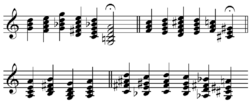Emancipation of the dissonance

The emancipation of the dissonance was a concept or goal put forth by composer Arnold Schoenberg and others, including his pupil Anton Webern. The phrase first appears in Schoenberg's 1926 essay "Opinion or Insight?" (Schoenberg 1975, 258–64). It may be described as a metanarrative to justify atonality. Jim Samson (1977, 146–47) describes:
As the ear becomes acclimatized to a sonority within a particular context, the sonority will gradually become 'emancipated' from that context and seek a new one. The emancipation of the dominant-quality dissonances has followed this pattern, with the dominant seventh developing in status from a contrapuntal note in the sixteenth century to a quasi-consonant harmonic note in the early nineteenth. By the later nineteenth century the higher numbered dominant-quality dissonances had also achieved harmonic status, with resolution delayed or omitted completely. The greater autonomy of the dominant-quality dissonance contributed significantly to the weakening of traditional tonal function within a purely diatonic context.
Composers such as Charles Ives, Dane Rudhyar, Duke Ellington, and Lou Harrison connected the emancipation of the dissonance with the emancipation of society and humanity. Michael Broyles calls Ives tone-cluster-rich song "Majority" as "an incantation, a mystical statement of belief in the masses or the people" (Broyles 1996, 125). Duke Ellington, after playing some of his pieces for a journalist, said, "That's the Negro's life ... Hear that chord! Dissonance is our way of life in America. We are something apart, yet an integral part" (Ellington 1963, 150). Lou Harrison described Carl Ruggles's counterpoint as "a community of singing lines, living a life of its own, . . . careful not to get ahead or behind in its rhythmic cooperation with the others" (Harrison 1946, 8). Rudhyar gave the subtitle "A New Principle of Musical and Social Organization" to his book Dissonant Harmony, writing, "Dissonant music is thus the music of true and spiritual Democracy; the music of universal brotherhoods; music of Free Souls, not of personalities. It abolishes tonalities, exactly as the real Buddhistic Reformation abolished castes into the Brotherhood of Monks; for Buddhism is nothing but spiritual Democracy" (Rudhyar 1928, 10–11).
Just as the harmonic series was and is used as a justification for consonance, such as by Rameau, among others, the harmonic series is often used as physical or psychoacoustic justification for the gradual emancipation of intervals and chords found further and further up the harmonic series over time, such as is argued by Henry Cowell in defense of his tone clusters. Some argue further that they are not dissonances, but consonances higher up the harmonic series and thus more complex. Chailley (1951, 12); cited in Nattiez 1990 gives the following diagram, a specific timeline he proposes:

A) unison and octave singing (magadizing) in Greek music and Ambrosian and Greek chant,
B) parallel fourths and fifths in organum "from c. 850"
C) "triadic music; from c. 1400"
D) chordal seventh, from c. 1600
E) chordal ninth, from c. 1750
F) whole-tone scale, from c. 1880"
G) total chromaticism, twelve-tone technique, and microtones in the early 20th-century.
A 1996 book by Thomas J. Harrison, 1910, the Emancipation of Dissonance, uses Schoenberg's "revolution" to trace other movements in the arts around that time.
Sources
- Broyles, Michael. 1996. "Charles Ives and the American Democratic Tradition", in Charles Ives and His World, ed. J. Peter Burkholder. Princeton, N.J.: Princeton University Press.
- Chailley, Jacques. 1951. Traité historique d'analyse musicale. Paris: Leduc.
- Cooper, Paul. 1973. Perspectives in Music Theory: An Historical-Analytical Approach. New York: Dodd, Mead. ISBN 0-396-06752-2.
- Ellington, Duke 1993. "Interview in Los Angeles: On Jump for Joy, Opera, and Dissonance as a 'Way of Life,'" reprinted in The Duke Ellington Reader, ed. Mark Tucker, 150. New York: Oxford University Press.
- Harrison, Lou. 1946. About Carl Ruggles. Yonkers, N.Y.: Oscar Baradinsky at the Alicat Bookshop.
- Harrison, Thomas J. 1996. 1910, the Emancipation of Dissonance. Berkeley: University of California Press.
- Lockspeiser, Edward. 1962. Debussy: His Life and Mind, p.207. ISBN 0-304-91878-4 for Vol. 1. cited in Nadeau, Roland (Sep., 1979), "Debussy and the Crisis of Tonality", p.71, Music Educators Journal, Vol. 66, No. 1, pp. 69-73.
- Nattiez, Jean-Jacques. 1990. Music and Discourse: Toward a Semiology of Music (Musicologie générale et sémiologie, 1987). Translated by Carolyn Abbate. ISBN 0-691-02714-5.
- Oja, Carol J. 1999. "Dane Rudhyar's Vision of American Dissonance." American Music (Summer): .
- Rudhyar, Dane. 1928. Dissonant Harmony: A New Principle of Musical and Social Organization. Carmel, California: Hamsa Publications.
- Samson, Jim. 1977. Music in Transition: A Study of Tonal Expansion and Atonality, 1900-1920. New York: W.W. Norton & Company. ISBN 0-393-02193-9.
- Schoenberg, Arnold. 1975. Style and Idea: Selected Writings of Arnold Schoenberg. Edited by Leonard Stein, with translations by Leo Black. New York: St. Martins Press; London: Faber & Faber. ISBN 0-520-05294-3. Expanded from the 1950 Philosophical Library (New York) publication edited by Dika Newlin. The volume carries the note "Several of the essays...were originally written in German (translated by Dika Newlin)" in both editions.
Further reading
- Stegemann, Benedikt. 2013. Theory of Tonality: Theoretical Studies. Wilhelmshaven: Noetzel. ISBN 978-3-7959-0963-5.